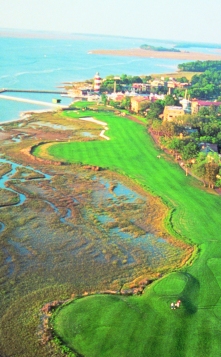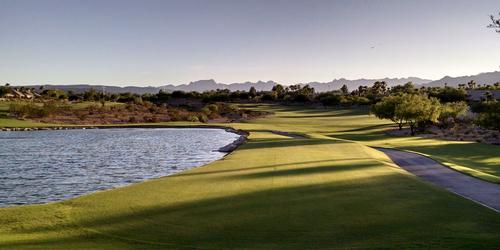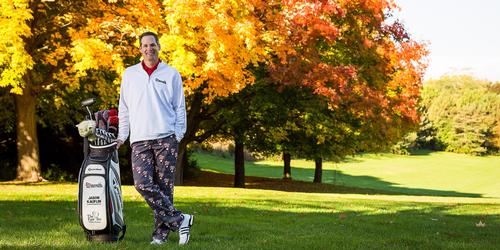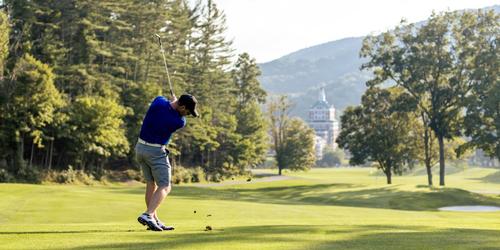Escape To Hilton Head, South Carolina
By Matt Tevsh

South Carolina vacation spot features some of the best public golf and best private getaways along the Atlantic Coast
The setting sun over the length of the lagoon is beaming its rays through the towering pines and into the screen porch of the villa at 7655 Huntington on the property of Palmetto Dunes. Under a small road bridge nearby, an egret stands patiently in the waters, quite possibly on the lookout for dinner. Just hours earlier, in the same spot, two kayakers passed, taking in the 75-degree weather, a variety of other wildlife, and even a few golf holes along the way.
Just over the bridge, through the gates leading to the Leamington properties, the Arthur Hills golf course is about to close for the day. One of the area's best golf courses is within walking distance, or a three-minute bike ride, making tomorrow morning's tee time at the break of dawn feel like a sleep-in.
This is a snapshot of Hilton Head Island, where so many activities never felt so relaxing, or so convenient. Long-known as one of the most laid-back and private vacation spots in the United States, Hilton Head offers something for everyone - including beaches, biking, boating, entertainment, shopping, and tennis - but golf is clearly one of its top draws. On the island itself, 18 courses are open to the public. Six properties are considered golf resort destinations. Two of the best are Palmetto Dunes and Sea Pines, which combined, offer six great courses.
Best value on the island
Sitting on 2,000 acres in the heart of Hilton Head along three miles of Atlantic Ocean beachfront, the Palmetto Dunes Oceanfront Resort is an idyllic site for golf. Strands of palmetto trees and towering oaks make their home on the property. Then there is an 11-mile lagoon running through the resort that serves as a habitat to over 40 species of birds and fish.
"Our lagoon system offers a remarkably creative approach to environmentally-friendly development," said Bret Martin, vice president of resort operations, in a press release. "Because of our lagoons, we have beautiful waterfront properties throughout the resort, as well as a gorgeous beach for our residents and guests. Palmetto Dunes has the distinction of being one of the only resorts in the Southeast that is completely surrounded by water, from the Atlantic Ocean to Shelter Cove Harbour, which gives the resort a unique waterfront atmosphere."
The lagoon, several ponds, and the ocean also play into 31 of 54 golf holes. Many of those water hazards are on the Arthur Hills course, one of best layouts on the island. Built on a series of rolling dunes, it runs 6,651 yards from the back tees (72.9 rating, 129 slope), the shortest of the three courses at the resort. But what the Hills might lack in length, it makes up for in strategy. Precise shot-making and positioning are paramount, often times dictated by the positioning of specific trees. Beautiful, huge, Spanish-moss draped oaks on Nos. 2, 5, and 12 especially can affect approach shots to the green. Said course designer Arthur Hills of the 399-yard 12th, a par four with water (and alligators) hugging the entire right side: "The fun starts here."
Giving the Hills course unique history is Hilton Head's first lighthouse, the Leamington (1881), behind the short, par-three No. 15. Tiger Woods and Phil Mickelson also competed as amateurs at the course in the Golf World Collegiate Championships.
Equally compelling as the Hills is the Robert Trent Jones course, which underwent a $3 million renovation in 2002 to which it received immediate praise. The 7,005-yard layout (74.3, 138) was named South Carolina's "Course of the Year" in 2003 (by the National Golf Course Owners Association).
The par-five 10th at the RTJ is considered its signature hole. Straightaway, but tight with six bunkers, it is one of only two oceanfront holes on Hilton Head Island. The Atlantic provides a backdrop to the green and then is behind golfers as they tee off on No.11. In all, water comes into play from No. 7 through No. 15, the most attractive stretch of holes on the course. Unique at the RTJ are "short course" tees designed specifically for juniors or high handicappers. On each hole, tee rocks are placed up the fairway at certain locations. Each short course hole ranges from 70 to 303 yards for an 18-hole total of 2,625 yards.
Completing the trio at Palmetto Dunes is the George Fazio course, the only par-70 course on Hilton Head, measuring 6,873 from the back tees. Eight of the course's 12 par fours can play over 400 yards including the signature No. 16 which sets the stage for a great finish. The same lagoon that runs the entire left side of the 16th is crossed on the long par-three 17th before the day's journey ends with a par five. The 18th features some Alister MacKenzie-like bunkering and a rare elevated green for a geographic region commonly referred to as the Lowcountry.
If the golf courses are not enough, Palmetto Dunes also has a staff of 10 professionals available for instruction. Led by director Doug Weaver, a former PGA Tour player, the Palmetto Dunes Golf Academy offers private and group lessons, two- and three-day golf schools, and clinics customized for juniors, women, and families. "So much of golf today is about proper mechanics, and we do not neglect that. However, for that guy that just came out of the Midwest or the Northeast, and he's cold and wants to get a quick start on his game, the last thing he wants is a long list of things to do. We kind of keep it like a theme that a picture is worth 1,000 words... so someone can come here and see a picture in their mind, and then that picture creates feelings and sensations. One of the things that I teach in every lesson is 'See it. Feel it. Trust it.'"
Rates for golf instruction vary depending on the package chosen, but like other activities at Palmetto Dunes, everything is value-driven without compromising quality. This past winter for a limited time, for example, lodging at one of the resort villas (that could sleep up to six with two bathrooms) and unlimited golf on any of the three courses went for just $99 per person per day.
Pebble Beach of the East
The most highly-acclaimed of Hilton Head Island's public golf destinations is the Sea Pines Resort, located on 5,000 oceanfront acres on the southern tip. Developed in 1956 by Georgia native and Yale graduate Charles Fraser as the first eco-planned resort in the world, it has become a standard for many other high-end resorts (Fraser also developed Kiawah Island Golf Resort near Charleston and Amelia Island Plantation, near Jacksonville).
If the East Coast has a Pebble Beach, Sea Pines is it. Whereas the west coast's paradise has its famous 17-mile drive and lone Cypress tree, Sea Pines has a scenic drive through the Sea Pines Forest Preserve and a 90-foot, red-and-white striped lighthouse which has become a trademark for not only Harbour Town Golf Links, but the entire island.
Harbour Town has routinely been ranked among the top 100 courses in the U.S. and has been the home of an annual PGA Tour event since 1969. The Verizon Heritage Tournament, held the week after the Masters, is one of the favorite stops for many PGA pros.
A Pete Dye-Jack Nicklaus collaboration, Harbour Town is different than any golf experience on Hilton Head, though it has much the same flora as Palmetto Dunes for example. Dye described his vision for Harbour Town in a press release saying, "I noticed that Mr. (Robert Trent) Jones was using big machinery to carve out long tees, huge bunkers and massive greens at nearby Palmetto Dunes at the time," recalls Dye. "I decided to do the opposite. I figured small greens, tiny pot bunkers, and a low profile design would separate my identity from the other designers on the island, and be something really unique."
That it is. Many of the greens are less than 30 yards deep. And at the pot bunker nestled in the crevice of the U-shaped green on the short par-four ninth (visible from the practice areas) has to be seen to be believed.
The four par threes at Harbour Town are among the best collection anywhere. All feature water, but none is tougher than No. 4, which can play up to 200 yards. It is a classic risk/reward hole with much of the left side of the green (just 27 yards deep) guarded by water.
Holes 13-18 provide a memorable finish. A large bunker with railroad ties supports the front of the 13th green creating an island-like feel and a potentially tough up-and-down. The par-five 15th is built like a true three-shot hole through the trees, and the 16th is a sharp dog-leg left known infamously for Stewart Cink's loose impediment drama in 2004.
Holes 17 and 18 mimic the final two at Pebble Beach. The penultimate hole is a short par three for most (185 from the tips), but can be a beast into the wind. The finish to the lighthouse on 18 features a wide landing area for the tee shot before a long approach shot to the green of the 452-yard par four. Spectacular views out over Calibogue Sound run the entire left-hand side of the hole with Daufuskie Island in the distance.
The Heron Point and Ocean courses at Sea Pines were both originally designed by George Cobb before undergoing extensive renovations. Heron Point, formerly known as Sea Marsh, was completely rebuilt by Dye in 2007. The Ocean course, the first course on Hilton Head (1960), was redesigned in 1995 by 10-time PGA Tour winner Mark McCumber.
The multi-million dollar complete transformation that formed Heron Point can play to over 7,100 yards. With a rating of 75.4 and a slope of 143, it is arguably the toughest course on the island for those willing to take on the challenge. Dye created mounding and movement in the fairways, and the penalties are harsh for missing fairways and greens.
By contrast, the Ocean course is a less demanding, more classic layout. The signature 15th, a 210-yard par-three that can play uphill into the wind, is an oceanfront hole.
The atmosphere at Sea Pines is completely service-oriented from arrival to departure. Each group is required to take a forecaddie and it is always cart-path only to ensure the best playing conditions. The starter even wears a kilt to lend to the ambiance.
Sea Pines' highly-rated golf academy features customized instruction packages that can include a round at Harbour Town. And outside of golf there is a spa, hayrides, and horseback riding at the beautiful Lawton stables. A supreme effort to preserve nature is evident throughout the Sea Pines property. No building at the resort is taller than the tallest magnolia or oak tree. And both the Ocean and Heron Point courses are Certified Audubon Cooperative Sanctuaries.
Article Tags: Hilton Head Golf
Revised: 11/08/2010 - Article Viewed 33,338 Times
About: Matt Tevsh
![]() Matt Tevsh has been a freelance sports journalist since 1996. He has been published in multiple periodicals including Midwest Golfing Magazine and on various websites including GolfTrips.com. He is an avid golfer and a former member of the Golf Writers Association of America.
Matt Tevsh has been a freelance sports journalist since 1996. He has been published in multiple periodicals including Midwest Golfing Magazine and on various websites including GolfTrips.com. He is an avid golfer and a former member of the Golf Writers Association of America.













